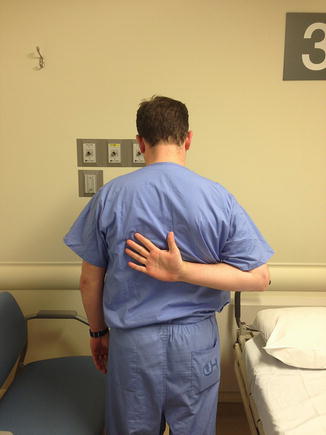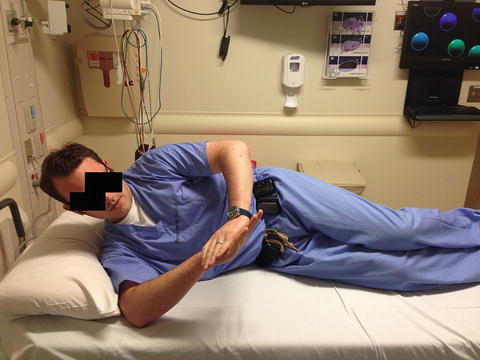Fig. 4.1
Assessing posterior capsular contracture with patient laying supine and the affected arm abducted to 90°

Fig. 4.2
Patient performing the active range of motion assessment of the posterior capsule by reaching up the spine to the most cephalad spinous process
The overhead throwing athlete presents with unique symptoms and findings related to posterior capsular tightness. In 1991, Verna was the first to describe a relationship between shoulder dysfunction and an internal rotation range of motion deficit seen in the dominant throwing arm of overhead athletes [11]. Since that time, many authors such as Burkhart et al. have gone on to describe this phenomenon known as glenohumeral internal rotation deficit (GIRD ) in which there is loss of degrees of glenohumeral internal rotation in the throwing shoulder compared to the non-throwing shoulder [12]. In Verna’s initial observation, 39 professional baseball pitchers were noted to have <25° of internal rotation with a loss of >35° compared to the non-throwing shoulder [11]. These players were followed from the beginning of spring training through the entire baseball season with 60 % of them developing shoulder dysfunction that required them to stop pitching during the season [11]. Kibler, in his work with Burkhart et al., described 38 overhead athletes with arthroscopically proven Type 2 SLAP tears and found that all presented with GIRD [12]. Interestingly, throwers manifest most posterior tightness in the posteroinferior capsule [12]. As stated, this contracture can cause a posterosuperior shift of the humeral head on the glenoid fossa which can subsequently cause a shearing stress on the posterosuperior aspect of the labrum and cuff, while the biceps tendon is exerting its maximal posterior restraining force vector (peel-back phenomenon ) seen in the late cocking phase of overhead throwing [12]. This increased stress leads to the higher likelihood of a SLAP lesion of the labrum. Additionally, these patients often have an increased external rotation range of motion in their throwing arm that can allow the greater tuberosity to become impinged under the posterosuperior aspect of the glenoid (posterior impingement) [1, 12].
Thomas has shown that posterior capsule tightness does correlate with increased capsular thickness as demonstrated on ultrasound [13]. Secondly, Thomas has also illustrated that increased amounts of humeral retroversion may predispose the thrower to acquire posterior inferior capsular contracture [14]. Increased humeral retroversion will cause an obligate loss of internal rotation. A diminished range of internal rotation will force the thrower to decelerate in a more confined motion arc and conceivably lead to earlier posterior cuff fatigue. Premature posterior rotator cuff fatigue may lead to increased posterior capsular strain and resultant fibrosis and thickening.
The initial approach to treating posterior capsule tightness should be nonsurgical in nature focused on stretching the tight posterior structures. The two most common and effective stretches focused on the posterior capsule are the cross-body adduction stretch and the “sleeper stretch .” The former is performed with the affected arm flexed up to 90° to be even with the height of the shoulders. The unaffected arm is then used to grab the forearm of the affected arm and bring it across the body toward the unaffected shoulder. For an increased stretch, the patient may bend the involved elbow and use the uninvolved hand to grasp the involved distal humerus rather than the forearm. The patient should feel a stretching sensation at the posterosuperior aspect of the affected shoulder. This stretch can be performed with the patient sitting upright or standing. The “sleeper stretch ” is performed with the patient lying on the affected shoulder side with the arm flexed up to 90° to be even with the level of the clavicle (Fig. 4.3). The unaffected hand is then placed on the posterior aspect of the affected side forearm and placed a downward force to internally rotate the arm. The patient will sense a stretch of the posteroinferior capsule. Both of these stretches should be held for 30–60 s and be performed about five times per day. In a study looking at NCAA Division I baseball players, Aldridge et al. had players perform a daily posterior capsule stretching program centered around the “sleeper stretch ” for 12 weeks [15]. The authors found that the players involved in the stretching program displayed significantly improved internal rotation and total range of motion arc in their dominant throwing arms. Other authors have suggested that the cross-body stretch is more effective than the “sleeper stretch” [16]. McClure et al. performed a randomized control trial comparing the two stretches with half of participants who displayed 10° or greater difference of internal rotation between their two shoulders placed into a 4-week cross-body stretch program with the other half placed in a 4-week “sleeper stretch” program. Both groups were compared to a control group who displayed less than 10° difference in their shoulder internal rotation arcs that performed no stretching program. Both stretching groups were found to have improvements in internal rotation compared to the control group, but only the cross-body stretching group was found to have significant gains (20.0 ± 12.9°) [16]. There was, however, no statistically significant difference in internal rotation gained between the two stretching groups [16]. Burkhart et al. have shown that nearly 90 % of throwers with symptomatic GIRD who are compliant with a focused posteroinferior stretching program will respond positively [1, 12].


Fig. 4.3
Patient position for performing the “sleeper stretch” of the posterior capsule
Although very successful with relatively low risk, not all patients respond well to nonoperative treatment of posterior capsular contracture. Thus, surgical capsular release may be indicated. It is important for the treating physician to remember that surgical treatment should only be considered once all nonoperative modalities have been exhausted. At least a 6-week course of stretching should be instituted before considering surgery. Some patients may show slight gains with nonoperative management which eventually plateau, whereas other patients may have refractory posterior shoulder tightness that shows no improvement with stretching at all. For either of these patients, we recommend obtaining an MRI imaging study prior to proceeding to the operating room to ensure that there is not an underlying pathology being missed on clinical examination. Having a preoperative MRI allows the treating surgeon to prepare properly for the operating room should there be a concurrent issue with the labrum, rotator cuff, or other structures of the shoulder.
Stay updated, free articles. Join our Telegram channel

Full access? Get Clinical Tree








